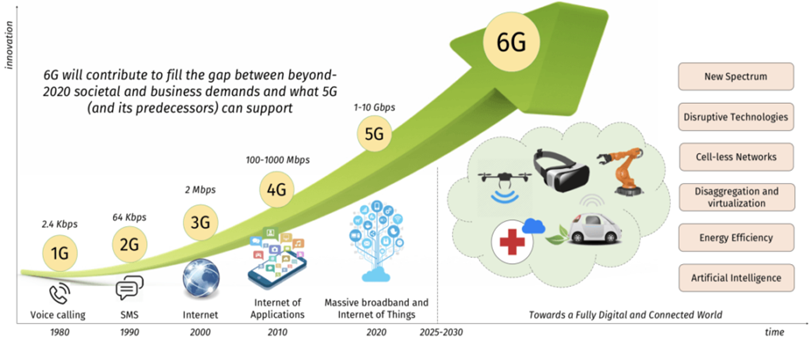Why in News?
- Recently, Prime Minister Narendra Modi unveiled the Bharat 6G Vision Document, a starting point for policymakers and the industry to gear up for the next generation of telecommunications.
What’s in Today’s Article?
- What is 6G (Meaning, Features, Comparison to 5G)
- India’s 6G Vision Document (India’s 6G Roadmap, Need, etc.)
About 6G Technology:
- Technically, not in existence today, 6G has been conceived as a far superior technology than 5G.
- As opposed to 5G, which at its peak can offer internet speeds up to 10 gigabits per second (GBPS), 6G promises to offer ultra-low latency with speeds up to 1 terabit per second (100 times faster than 5G).
- Latency is the time taken for a data packet to move from one place to another.
- On the other hand, speed is the number of such packets that can travel on a connection each second.
- Its application will include remote-controlled factories, constantly communicating self-driven cars and smart wearables taking inputs directly from human senses.
- However, since the majority of 6G supporting communication devices will be battery-powered and can have a high carbon footprint, it will also need to be balanced with sustainability.

What is India’s 6G Roadmap?
- The Government of India formally launched 5G services in October 2022 and said that India should be ready to launch 6G services in the next 10 years.
- The Bharat 6G project will be implemented in two phases and the government has also appointed an apex council to oversee the project and focus on issues such as –
- Standardisation,
- Identification of the spectrum for 6G usage,
- Create an ecosystem for devices and systems, and
- Figure out finances for research and development, etc.
- In Phase One (from 2023 to 2025), support will be provided to explorative ideas, risky pathways and proof-of-concept tests.
- Ideas and concepts that show promise and potential for acceptance by the global peer community will be adequately supported to develop them to completion, leading to commercialisation as part of Phase Two (from 2025 to 2030).
- To fund research and innovation on 6G, the document recommended the creation of a corpus of Rs 10,000 crore to facilitate various funding instruments such as grants, loans, VC fund, etc.
- Some indicative goals are to –
- Guarantee every citizen a minimum bandwidth of 100Mbps;
- Ensure every gram panchayat has half a terabit per second of connectivity; and
- Blanket the country with over 50 million internet hotspots, with thirteen per square km.
Why did the Government put out a 6G Vision Document?
- To accelerate India’s wireless data consumption lead and assume leadership in setting the standards for 6G in the coming years.
- This may involve everything from encouraging local manufacturing of telecom gear to supporting Indian companies and engineers in international discussions around standardisation.
- Standardisation is key, as telecommunications standards are usually adopted globally.
- Delay in previous generations of telecommunications technology rolling out in India.
- For example, 5G was rolled out years after countries like South Korea and the US had already covered their major urban areas with high-speed wireless connectivity.
- India does not want a repeat of that.
- Yet another reason is pure physics –
- Frequencies generally increase in newer generations of networks, but the lower the frequency, the longer a cell signal can travel.
- With increasing data usage, lower frequencies in 4G networks may not physically be able to keep up with the demand for traffic.
How are Other Countries Looking at the 6G Rollout?
- South Korea has outlined a 6G research and development plan with Rs 1200 crore worth of investments in the first phase running till 2025.
- In Japan, the Integrated Optical and Wireless Network (IOWN) Forum has published its Vision 2030 for 6G for infrastructure evolution in four dimensions – cognitive capacity, responsiveness, scalability, and energy efficiency.
- Key developments in 6G have also been identified and are being pursued in China, in order to support connectivity plus sensing plus Artificial Intelligence (AI).










